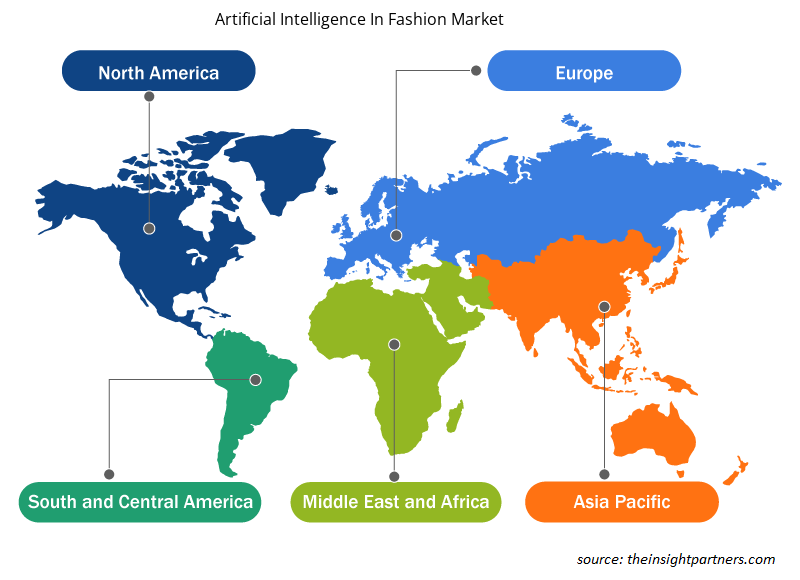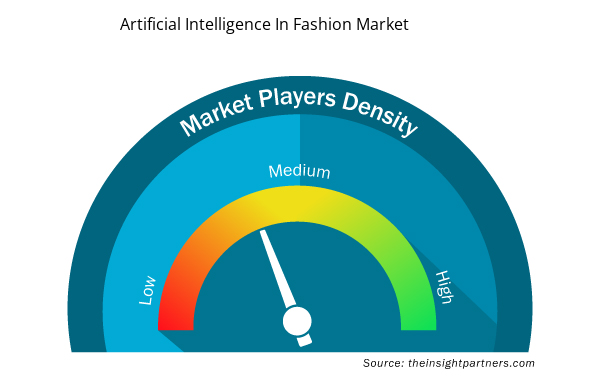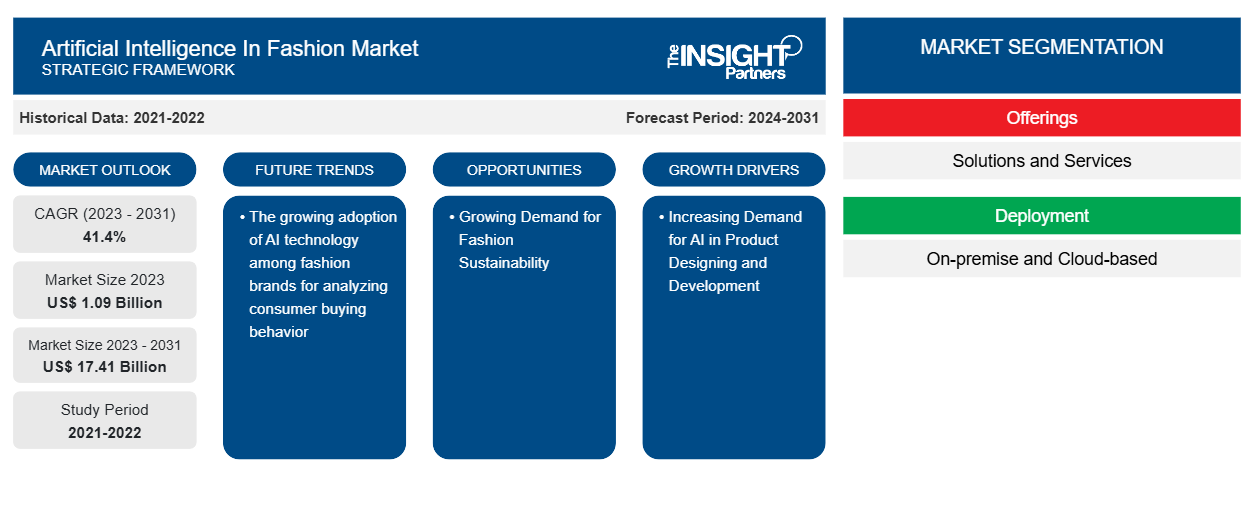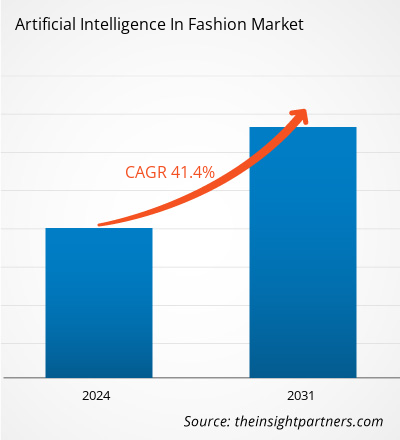ファッションにおける人工知能の市場規模は、2023年の10億9,000万米ドルから2031年には174億1,000万米ドルに達すると予測されています。市場は2023年から2031年にかけて41.4%のCAGRを記録すると予想されています。消費者の購買行動を分析するためにファッションブランドの間でAI技術の採用が増えていることは、ファッション市場の動向における人工知能の重要な部分であり続けると思われます。
ファッション市場分析における人工知能
ファッション市場における人工知能は、製品設計と開発における AI の需要の高まりと、パーソナライズされた体験に対する顧客の需要の高さにより、急速に成長しています。在庫管理における AI の需要の高まりにより、市場は着実に拡大しています。さらに、ファッションの持続可能性に対する需要の高まりとファストファッション小売の成長は、市場の成長にとって有利な機会を提供しています。
ファッション市場における人工知能の概要
人工知能は、製品ライフサイクルの多くの領域を改善し、アパレルの生産、販売、着用方法を再定義することで、ファッション業界を変革しています。最先端のテクノロジーは、デザイナー、小売業者、消費者に変革をもたらします。ファッションデザイナーは、人工知能を使用して創造力を最大限に引き出し、デザインの革新を推進します。デザイナーは、AI アルゴリズムを使用して膨大な量の過去のファッションデータを調べ、ファッション業界の潜在的なトレンドを特定することで、新しい革新的なアイデアを生み出すことができます。
AI を活用した推奨システムは、個人の興味に基づいて個別の製品提案を提供することで、顧客の購入体験を向上させます。AI は、ファッション ブランドが閲覧履歴、購入行動、スタイルの好みなどのユーザー データを評価し、消費者の嗜好や興味に基づいてパーソナライズされた提案を作成することをサポートします。このカスタマイズにより、顧客エンゲージメントが向上し、ブランド ロイヤルティが構築され、売上コンバージョンが増加します。
要件に合わせてレポートをカスタマイズする
このレポートの一部、国レベルの分析、Excelデータパックなど、あらゆるレポートを無料でカスタマイズできます。また、スタートアップや大学向けのお得なオファーや割引もご利用いただけます。
- このレポートの主要な市場動向を入手してください。この無料サンプルには、市場動向から見積もりや予測に至るまでのデータ分析が含まれます。
ファッション市場における人工知能の推進力と機会
製品設計と開発におけるAIの需要増加が市場を牽引
AIはファッション業界の製品設計と開発において重要な役割を果たしています。業界では、AIを活用したツールをクリエイティブプロセスに徹底的に統合し、多くのデザイン面を合理化および改善して、製品のライフサイクル全体にわたって効率を高め、イノベーションを促進しています。AIは製品設計におけるパターン最適化に大きく使用されており、材料効率の最大化が市場を牽引しています。AIアルゴリズムは設計基準と材料品質を検査して、無駄を減らしながらリソースを最大限に活用する最適なパターンを開発します。このテクノロジーは、設計者がコスト削減と環境持続可能性の目標を達成し、設計の整合性を維持するのにも役立ちます。これらの要因は、予測期間中に市場を活性化すると予想されます。
ファッションの持続可能性に対する需要の高まり - ファッション市場における人工知能のチャンス
ファッション業界は、持続可能な方法と倫理的な材料調達にますます重点を置いています。AI は、製品用の持続可能な材料の選択を容易にし、ファッション企業に重要な洞察と支援を提供する上で重要な役割を果たします。AI アルゴリズムは、持続可能性のために材料を評価する際に多くの要素を調べるのに役立ちます。これらの要素には、倫理的な調達手順、費用対効果の考慮、環境影響調査が含まれます。AI は、大規模なデータセットと複雑な要素を評価することで、ファッション企業が製品に使用する材料について情報に基づいた決定を下し、持続可能性の願望とビジネス目標のバランスをとることを可能にします。
さらに、消費者の意識と環境への懸念が高まるにつれて、持続可能なファッションに対する高まるニーズを満たすために AI アルゴリズムの採用が増加しています。衣服の環境への影響に関する消費者の懸念が高まるにつれて、ファッション ブランドは製造およびサプライ チェーン全体で持続可能な慣行を実施するよう促されています。これらの要因により、市場に大きな成長の機会が生まれています。
ファッション市場レポートにおける人工知能のセグメンテーション分析
ファッション市場分析における人工知能の導出に貢献した主要なセグメントは、提供、展開、アプリケーション、およびエンドユーザー業界です。
- ファッション市場における人工知能は、提供内容に基づいてソリューションとサービスに分かれています。ソリューションセグメントは2023年に大きな市場シェアを占めました。
- 展開に基づいて、市場はオンプレミスとクラウドベースに分かれています。クラウドベースのセグメントは、2023年に大きな市場シェアを占めました。
- アプリケーションに基づいて、ファッション市場における人工知能は、製品推奨、仮想アシスタント、製品検索と発見、クリエイティブデザインとトレンド予測、顧客関係管理などに分かれています。製品推奨セグメントは、2023年に大きな市場シェアを占めました。
- エンドユーザー産業の観点から見ると、ファッション市場における人工知能は、アパレル、アクセサリー、化粧品などに分類されます。アパレル部門は2023年に大きな市場シェアを占めました。
ファッション市場における人工知能の地域別シェア分析
ファッション市場における人工知能レポートの地理的範囲は、主に北米、アジア太平洋、ヨーロッパ、中東およびアフリカ、南米/中南米の 5 つの地域に分かれています。
収益面では、ファッション業界での AI 技術の採用が増えているため、北米市場がファッション市場における人工知能の最大のシェアを占めています。技術の向上とファッション アプリケーションにおける人工知能の早期使用が市場を牽引しています。同様に、米国やカナダなどの国で新たに出現したファッション トレンドにより、生産性の向上、販売の最適化、持続可能性のための AI 技術の需要が急増しています。さらに、ファッション業界のダイナミックな性質と消費者需要の絶え間ない変化により、イノベーションと競争を推進するための AI の需要が高まっています。
ファッション市場における人工知能の地域的洞察
予測期間を通じてファッションにおける人工知能市場に影響を与える地域的な傾向と要因は、Insight Partners のアナリストによって徹底的に説明されています。このセクションでは、北米、ヨーロッパ、アジア太平洋、中東、アフリカ、南米、中米にわたるファッションにおける人工知能市場のセグメントと地理についても説明します。

- ファッション市場における人工知能の地域別データを入手
ファッション市場における人工知能レポートの範囲
| レポート属性 | 詳細 |
|---|---|
| 2023年の市場規模 | 10億9000万米ドル |
| 2031年までの市場規模 | 174億1000万米ドル |
| 世界のCAGR(2023年~2031年) | 41.4% |
| 履歴データ | 2021-2022 |
| 予測期間 | 2024-2031 |
| 対象セグメント | 提供物によって
|
| 対象地域と国 | 北米
|
| 市場リーダーと主要企業プロフィール |
|
ファッション市場における人工知能のプレーヤー密度: ビジネスダイナミクスへの影響を理解する
ファッション市場における人工知能市場は、消費者の嗜好の変化、技術の進歩、製品の利点に対する認識の高まりなどの要因により、エンドユーザーの需要が高まり、急速に成長しています。需要が高まるにつれて、企業は提供を拡大し、消費者のニーズを満たすために革新し、新たなトレンドを活用し、市場の成長をさらに促進しています。
市場プレーヤー密度とは、特定の市場または業界内で活動している企業または会社の分布を指します。これは、特定の市場スペースに、その規模または総市場価値と比較して、どれだけの競合相手 (市場プレーヤー) が存在するかを示します。
ファッション市場における人工知能で事業を展開している主要企業は次のとおりです。
- アドビ株式会社
- アルファベット社(Google)
- Amazon.com, Inc.
- ファーウェイテクノロジーズ株式会社
- IBMコーポレーション
- マイクロソフト株式会社
免責事項:上記の企業は、特定の順序でランク付けされていません。

- ファッション市場における人工知能のトップキープレーヤーの概要を入手
ファッション市場における人工知能のニュースと最近の動向
ファッション市場における人工知能は、主要な企業出版物、協会データ、データベースなど、一次および二次調査後の定性的および定量的データを収集することによって評価されます。以下は、ファッションにおける人工知能の市場と戦略の動向のリストです。
- LS&Co.は2023年3月、カスタマイズされたAI生成モデルを構築するデジタルファッションスタジオであるLalaland.aiとの提携を発表しました。両社は、AI生成モデルを人間のモデルを補完するためにテストおよび使用し、持続可能な方法で製品モデルの数と多様性を増やすことを計画しています。(出典:LS&Co.、プレスリリース、2023年)
ファッション市場における人工知能レポートのカバレッジと成果物
「ファッションにおける人工知能の市場規模と予測(2021〜2031年)」レポートでは、以下の分野をカバーする市場の詳細な分析を提供しています。
- 対象範囲に含まれるすべての主要市場セグメントの世界、地域、国レベルでの市場規模と予測
- 市場の動向(推進要因、制約、主要な機会など)
- 今後の主な動向
- 詳細なPEST/ポーターの5つの力とSWOT分析
- 主要な市場動向、主要プレーヤー、規制、最近の市場動向を網羅した世界および地域の市場分析
- 市場集中、ヒートマップ分析、主要プレーヤー、最近の動向を網羅した業界の状況と競争分析
- 詳細な企業プロフィール
- 過去2年間の分析、基準年、CAGRによる予測(7年間)
- PEST分析とSWOT分析
- 市場規模価値/数量 - 世界、地域、国
- 業界と競争環境
- Excel データセット



Report Coverage
Revenue forecast, Company Analysis, Industry landscape, Growth factors, and Trends

Segment Covered
This text is related
to segments covered.

Regional Scope
North America, Europe, Asia Pacific, Middle East & Africa, South & Central America

Country Scope
This text is related
to country scope.
よくある質問
The incremental growth expected to be recorded for the global artificial intelligence in fashion market during the forecast period is US$ 16.32 billion.
The global artificial intelligence in fashion market is expected to reach US$ 17.41 billion by 2031.
The key players holding majority shares in the global artificial intelligence in fashion market are Adobe Inc., Alphabet Inc. (Google), Amazon.com, Inc., Huawei Technologies Co., Ltd., and IBM Corporation.
The growing adoption of AI technology among fashion brands for analyzing consumer buying behavior to play a significant role in the global artificial intelligence in the fashion market in the coming years.
The increasing demand for AI in product design and development and the high customer demand for a personalized experience are the major factors that propel the global artificial intelligence in fashion market.
The global artificial intelligence in fashion market was estimated to be US$ 1.09 billion in 2023 and is expected to grow at a CAGR of 41.4% during the forecast period 2023 - 2031.s
Trends and growth analysis reports related to Technology, Media and Telecommunications : READ MORE..
The Insight Partners performs research in 4 major stages: Data Collection & Secondary Research, Primary Research, Data Analysis and Data Triangulation & Final Review.
- Data Collection and Secondary Research:
As a market research and consulting firm operating from a decade, we have published and advised several client across the globe. First step for any study will start with an assessment of currently available data and insights from existing reports. Further, historical and current market information is collected from Investor Presentations, Annual Reports, SEC Filings, etc., and other information related to company’s performance and market positioning are gathered from Paid Databases (Factiva, Hoovers, and Reuters) and various other publications available in public domain.
Several associations trade associates, technical forums, institutes, societies and organization are accessed to gain technical as well as market related insights through their publications such as research papers, blogs and press releases related to the studies are referred to get cues about the market. Further, white papers, journals, magazines, and other news articles published in last 3 years are scrutinized and analyzed to understand the current market trends.
- Primary Research:
The primarily interview analysis comprise of data obtained from industry participants interview and answers to survey questions gathered by in-house primary team.
For primary research, interviews are conducted with industry experts/CEOs/Marketing Managers/VPs/Subject Matter Experts from both demand and supply side to get a 360-degree view of the market. The primary team conducts several interviews based on the complexity of the markets to understand the various market trends and dynamics which makes research more credible and precise.
A typical research interview fulfils the following functions:
- Provides first-hand information on the market size, market trends, growth trends, competitive landscape, and outlook
- Validates and strengthens in-house secondary research findings
- Develops the analysis team’s expertise and market understanding
Primary research involves email interactions and telephone interviews for each market, category, segment, and sub-segment across geographies. The participants who typically take part in such a process include, but are not limited to:
- Industry participants: VPs, business development managers, market intelligence managers and national sales managers
- Outside experts: Valuation experts, research analysts and key opinion leaders specializing in the electronics and semiconductor industry.
Below is the breakup of our primary respondents by company, designation, and region:

Once we receive the confirmation from primary research sources or primary respondents, we finalize the base year market estimation and forecast the data as per the macroeconomic and microeconomic factors assessed during data collection.
- Data Analysis:
Once data is validated through both secondary as well as primary respondents, we finalize the market estimations by hypothesis formulation and factor analysis at regional and country level.
- Macro-Economic Factor Analysis:
We analyse macroeconomic indicators such the gross domestic product (GDP), increase in the demand for goods and services across industries, technological advancement, regional economic growth, governmental policies, the influence of COVID-19, PEST analysis, and other aspects. This analysis aids in setting benchmarks for various nations/regions and approximating market splits. Additionally, the general trend of the aforementioned components aid in determining the market's development possibilities.
- Country Level Data:
Various factors that are especially aligned to the country are taken into account to determine the market size for a certain area and country, including the presence of vendors, such as headquarters and offices, the country's GDP, demand patterns, and industry growth. To comprehend the market dynamics for the nation, a number of growth variables, inhibitors, application areas, and current market trends are researched. The aforementioned elements aid in determining the country's overall market's growth potential.
- Company Profile:
The “Table of Contents” is formulated by listing and analyzing more than 25 - 30 companies operating in the market ecosystem across geographies. However, we profile only 10 companies as a standard practice in our syndicate reports. These 10 companies comprise leading, emerging, and regional players. Nonetheless, our analysis is not restricted to the 10 listed companies, we also analyze other companies present in the market to develop a holistic view and understand the prevailing trends. The “Company Profiles” section in the report covers key facts, business description, products & services, financial information, SWOT analysis, and key developments. The financial information presented is extracted from the annual reports and official documents of the publicly listed companies. Upon collecting the information for the sections of respective companies, we verify them via various primary sources and then compile the data in respective company profiles. The company level information helps us in deriving the base number as well as in forecasting the market size.
- Developing Base Number:
Aggregation of sales statistics (2020-2022) and macro-economic factor, and other secondary and primary research insights are utilized to arrive at base number and related market shares for 2022. The data gaps are identified in this step and relevant market data is analyzed, collected from paid primary interviews or databases. On finalizing the base year market size, forecasts are developed on the basis of macro-economic, industry and market growth factors and company level analysis.
- Data Triangulation and Final Review:
The market findings and base year market size calculations are validated from supply as well as demand side. Demand side validations are based on macro-economic factor analysis and benchmarks for respective regions and countries. In case of supply side validations, revenues of major companies are estimated (in case not available) based on industry benchmark, approximate number of employees, product portfolio, and primary interviews revenues are gathered. Further revenue from target product/service segment is assessed to avoid overshooting of market statistics. In case of heavy deviations between supply and demand side values, all thes steps are repeated to achieve synchronization.
We follow an iterative model, wherein we share our research findings with Subject Matter Experts (SME’s) and Key Opinion Leaders (KOLs) until consensus view of the market is not formulated – this model negates any drastic deviation in the opinions of experts. Only validated and universally acceptable research findings are quoted in our reports.
We have important check points that we use to validate our research findings – which we call – data triangulation, where we validate the information, we generate from secondary sources with primary interviews and then we re-validate with our internal data bases and Subject matter experts. This comprehensive model enables us to deliver high quality, reliable data in shortest possible time.


 このレポートの無料サンプルを入手する
このレポートの無料サンプルを入手する